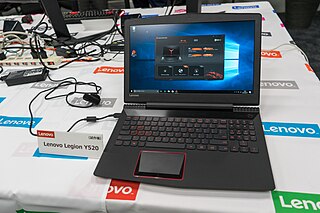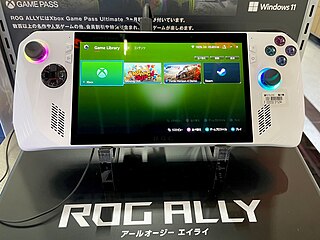
A handheld game console, or simply handheld console, is a small, portable self-contained video game console with a built-in screen, game controls and speakers. Handheld game consoles are smaller than home video game consoles and contain the console, screen, speakers, and controls in one unit, allowing players to carry them and play them at any time or place.
Samsung Notebook, formerly known as Samsung Sens, also marketed as Samsung Notebook Series (2011—2013), is a line of portable computers produced by Samsung Electronics. The Sens line was first launched in 1995 and lasted until 2013, exported overseas without the Sens branding, and replaced by Samsung Ativ. Ativ itself was also dropped in favor of Samsung Notebook. As of 2020, Samsung Notebook co-exists with the company's Galaxy Book line of laptops but is facing transition.

An ultra-mobile PC, or ultra-mobile personal computer (UMPC), is a miniature version of a pen computer, a class of laptop whose specifications were launched by Microsoft and Intel in Spring 2006. Sony had already made a first attempt in this direction in 2004 with its Vaio U series, which was only sold in Asia. UMPCs are generally smaller than subnotebooks, have a TFT display measuring (diagonally) about 12.7 to 17.8 centimetres, are operated like tablet PCs using a touchscreen or a stylus, and can also have a physical keyboard. There is no clear boundary between subnotebooks and ultra-mobile PCs, but UMPCs commonly have major features not found in the common clamshell laptop design, such as small keys on either side of the screen, or a slide-out keyboard.

Windows IoT, short for Windows Internet of Things and formerly known as Windows Embedded, is a family of operating systems from Microsoft designed for use in embedded systems. Microsoft has three different subfamilies of operating systems for embedded devices targeting a wide market, ranging from small-footprint, real-time devices to point of sale (POS) devices like kiosks. Windows Embedded operating systems are available to original equipment manufacturers (OEMs), who make it available to end users preloaded with their hardware, in addition to volume license customers in some cases.
The AMD Bulldozer Family 15h is a microprocessor microarchitecture for the FX and Opteron line of processors, developed by AMD for the desktop and server markets. Bulldozer is the codename for this family of microarchitectures. It was released on October 12, 2011, as the successor to the K10 microarchitecture.

Haswell is the codename for a processor microarchitecture developed by Intel as the "fourth-generation core" successor to the Ivy Bridge. Intel officially announced CPUs based on this microarchitecture on June 4, 2013, at Computex Taipei 2013, while a working Haswell chip was demonstrated at the 2011 Intel Developer Forum. With Haswell, which uses a 22 nm process, Intel also introduced low-power processors designed for convertible or "hybrid" ultrabooks, designated by the "U" suffix.

Ivy Bridge is the codename for Intel's 22 nm microarchitecture used in the third generation of the Intel Core processors. Ivy Bridge is a die shrink to 22 nm process based on FinFET ("3D") Tri-Gate transistors, from the former generation's 32 nm Sandy Bridge microarchitecture—also known as tick–tock model. The name is also applied more broadly to the Xeon and Core i7 Extreme Ivy Bridge-E series of processors released in 2013.

Steam Machine is a discontinued series of small form factor gaming computers by Valve, designed to operate SteamOS to provide a game console-like experience. Several computer vendors were engaged with Valve to develop their own versions of Steam Machines for retail, offering additional options atop Valve's requirements such as dual-booting options with Microsoft Windows and the ability to upgrade the computer. Consumers could digitally purchase video games on their Steam Machine through Valve's namesake Steam storefront.

SteamOS is a Linux distribution developed by Valve. It incorporates Valve's popular namesake Steam video game storefront and is the primary operating system for the Steam Deck, Valve's portable gaming device, as well as Valve's earlier Steam Machines. SteamOS is open source with some closed source components.

Windows Mixed Reality (WMR) is a discontinued platform by Microsoft which provides augmented reality and virtual reality experiences with compatible head-mounted displays.

GPD Win is a Windows-based palmtop computer equipped with a keyboard and video game controls. It is an x86-based device that runs Windows 10. It is capable of running any x86 Windows-based application that can run within the confines of the computer's hardware. First announced in October 2015, it was crowdfunded via Indiegogo and two other crowdfunding sites in Japan and China. The GPD Win was released in October 2016.
The ninth generation of video game consoles began in November 2020 with the releases of Microsoft's Xbox Series X and Series S console family and Sony's PlayStation 5.

Alder Lake is Intel's codename for the 12th generation of Intel Core processors based on a hybrid architecture utilizing Golden Cove performance cores and Gracemont efficient cores. It is fabricated using Intel's Intel 7 process, previously referred to as Intel 10 nm Enhanced SuperFin (10ESF). The 10ESF has a 10%-15% boost in performance over the 10SF used in the mobile Tiger Lake processors. Intel officially announced 12th Gen Intel Core CPUs on October 27, 2021, mobile CPUs and non-K series desktop CPUs on January 4, 2022, Alder Lake-P and -U series on February 23, 2022, and Alder Lake-HX series on May 10, 2022.
The GPD Win Max is a Windows-based palmtop computer manufactured by Gamepad Digital (GPD). It is the successor to the GPD Win 2, and was crowdfunded, like its predecessor. Announced in the first quarter of 2020, the crowdfunding campaign was launched on Indiegogo on May 18, 2020, priced at $779. The campaign concluded on July 1, 2020 with more than 3,500 backers having contributed more than $2.8 million dollars in total.

Apple M1 is a series of ARM-based system-on-a-chip (SoC) designed by Apple Inc. as a central processing unit (CPU) and graphics processing unit (GPU) for its Mac desktops and notebooks, and the iPad Pro and iPad Air tablets. The M1 chip initiated Apple's third change to the instruction set architecture used by Macintosh computers, switching from Intel to Apple silicon 14 years after they were switched from PowerPC to Intel, and 26 years after the transition from the original Motorola 68000 series to PowerPC. At the time of introduction in 2020, Apple said that the M1 had the world's fastest CPU core "in low power silicon" and the world's best CPU performance per watt. Its successor, Apple M2, was announced on June 6, 2022, at Worldwide Developers Conference (WWDC).

Lenovo Legion is a line of consumer-oriented laptops, desktop computers, smartphone, and tablet computers designed, developed and marketed by Lenovo, targeting gaming performance. The first Legion brand laptops, the Legion Y520 and the Legion Y720, were revealed at CES 2017 and succeeded the IdeaPad Y series. On June 6, 2017, a high-performance model, the Legion Y920, equipped with Intel's seventh-generation quad-core i7-7820HK and Nvidia GTX 1070 discrete graphics, was launched.

The Steam Deck is a handheld gaming computer developed by Valve and released on February 25, 2022. The device uses Valve's Linux distribution SteamOS, which incorporates the namesake Steam storefront. SteamOS uses Valve's Proton compatibility layer, allowing users to run Windows applications and games. In addition to handheld use, the Steam Deck can be connected to a TV or monitor through a docking station and be used like a desktop computer or home video game console. In desktop mode, users can install third-party applications for Linux.

Ayaneo is a Chinese brand of handheld gaming computers and mini PCs using the Microsoft Windows operating system and AMD Ryzen processors.

The Asus ROG Ally is a handheld gaming computer developed and manufactured by Asus under their Republic of Gamers brand which is often known as ROG. Released on June 13, 2023, the device competes with Valve's Steam Deck. The ROG Ally runs the Windows 11 operating system and uses an AMD Zen 4 processor called the AMD Z1 and Z1 Extreme. In addition to handheld use, the ROG Ally can be connected to a TV or monitor through a docking station or a dongle and be used like a desktop computer or home video game console.
Meteor Lake is Intel's codename for the first generation of Intel Core Ultra mobile processors, and was officially launched on December 14, 2023. It is the first generation of Intel mobile processors to use a chiplet architecture. Tim Wilson led the system on a chip development for this generation microprocessor.














